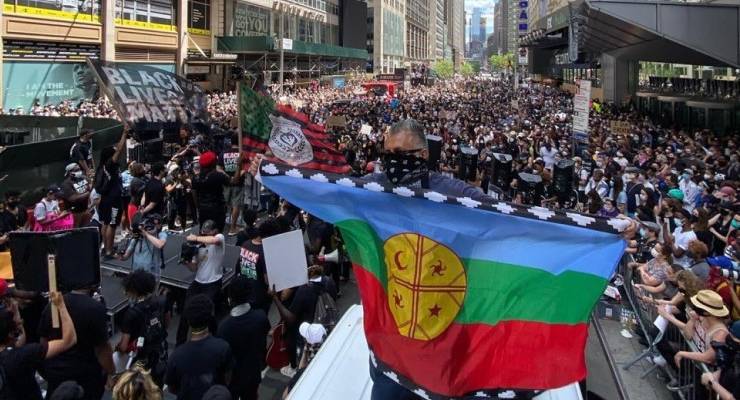
Sean Monterrosa, a Latino, was fatally shot by Vallejo police in California’s San Francisco Bay area within days of the killing of African American George Floyd on May 25. Monterrosa was shot five times by a cop who, apparently, mistook a hammer on his waistband for a gun.
Today Floyd’s funeral took place in his home town of Houston. Houston is also the home town of Latino Vietnam War veteran José Campos Torres who, on May 5, 1977, was beaten to death by a group of police officers. Campos Torres was 23.
The police killing of black people in the United States has attracted well-justified global attention and condemnation — and Black Lives Matter has become a formidable statement. This can’t be said about US police killing of Latinos and Latinas. And while the words “Brown Lives Matter” have been uttered here and there, they haven’t gained much traction.
Monterrosa was from San Francisco. He was 22. He is one new name on the fateful count of Latinos and Latinas killed by US police officers: Francisco Serna in California; Antonio Zambrano-Montes in Washington; Antonio Arce in Tempe; Jessica Hernández in Colorado. Just some of the names that leap to mind.
“And don’t forget Anthony Báez,” activist and community organiser Nieves Ayrees reminded me. Anthony Báez was shot down by police officer Francis Livoti in 1994.
“Báez used to live around here, where I live,” Ayrees tells me on the phone from her home in New York’s South Bronx. The killing of Báez sparked one of the most massive protests by the Latino community against police brutality ever seen.
“It went for weeks and weeks,” she says.
The Latino population in the US is nearly 58 million, according to the Pew Research Centre. Behind whites, Latinos are the second-largest racial or ethnic group. It is a population badly hit by discrimination — 78% of Latinos reported facing discrimination.
It is also a community badly hit by trigger-happy police officers. A 2018 study showed that “Latino men’s risk of being killed by police is about 40% higher than the risk faced by white men”. And a 2018 study from Washington University in St Louis said young Latino men faced the highest risk from police shootings.
In the past five years, US police killed 23 Latinos for every million inhabitants in the country. In 2016 Eric Rodriguez, a leading figure at UnidosUS — the largest Latino advocacy organisation in the US — told PBS that “police killings of brown people often go under-reported”.
One of those under-reported deaths was that of 20-year-old Guatemalan Amilcar Perez-Lopez, shot dead by two plain-clothed San Francisco police officers in February 2015. Perez-Lopez was one of 67 Latinos identified by The Guardian as killed by police during the first half of 2015 alone.
The beating heart of the Latino community is in California, where 15 million Latinos live — more than 27% of America’s Latino population. In 2017 Latinos accounted for nearly 50% of the 172 people killed by police in California.
LatinoJustice president and general counsel Juan Cartagena says: “Between 2007 and 2014, half of the people who died in encounters with police officers in Los Angeles County were Latino.”
The US southern border with Mexico has long been renowned as a graveyard for Latinos and Latinas killed by US police and border patrol. In 2019 a border patrol agent shot and killed 20-year-old Guatemalan woman Claudia Patricia Gomez Gonzalez, and early this year a lengthy judicial process was concluded over the 2010 border patrol killing of Sergio Hernández, a Mexican.
The relative public invisibility of police killings of Latinos is “partly because Latino activists haven’t mobilised in the same way as black activists”, writes NPR reporter Adrian Florido. Ayrees tells me this lack of public mobilisation is primarily due to fear of “la migra” — immigration agents.
In contrast to the African American community that has placed an end to police brutality high in its demands, the Latino community is more concerned with immigration.
Lawyer Luis Carrillo, who has represented Latino families in cases of police brutality, told The Los Angeles Times that Latin America’s history of military dictatorships and police oppression has made Latinos fearful of the police — not attracting the attention of police has become a rule of survival. The Latino community, says Carrillo, has adhered to a “no waves” mentality: don’t rock the boat.
This mentality has been further reinforced by the conservative nature of large sections of the Latino community. This is particularly manifested in the influence that Catholic and evangelical churches — especially rapidly growing Pentecostal churches — have on the Latino community.
In stark contrast to many African American churches that have been at the vanguard of the Black Lives Matter movement, Latino religious leaders have remained silent on US police killing of Latinos.
However, things are apparently changing. Calls for Latinos to respond to police brutality have become louder in recent weeks.
Last week Hispanic Quality of Life Commission vice chair Angelica Erazo was spot on when she told NBC: “All too often we [Latinos] do not show up when it comes to police violence.”
Last week all across the US Latinos did show up — to “not leave all the heavy lifting to the black community”, as Erazo put it. It is possible that the killing of George Floyd has given Latinos the impetus to speak up against police brutality and, perhaps, to say loudly and clearly that Brown Lives Matter too.
Antonio Castillo, PhD, is a Latin American journalist and academic. Currently he teaches journalism at RMIT University.







Crikey encourages robust conversations on our website. However, we’re a small team, so sometimes we have to reluctantly turn comments off due to legal risk. Thanks for your understanding and in the meantime, have a read of our moderation guidelines.